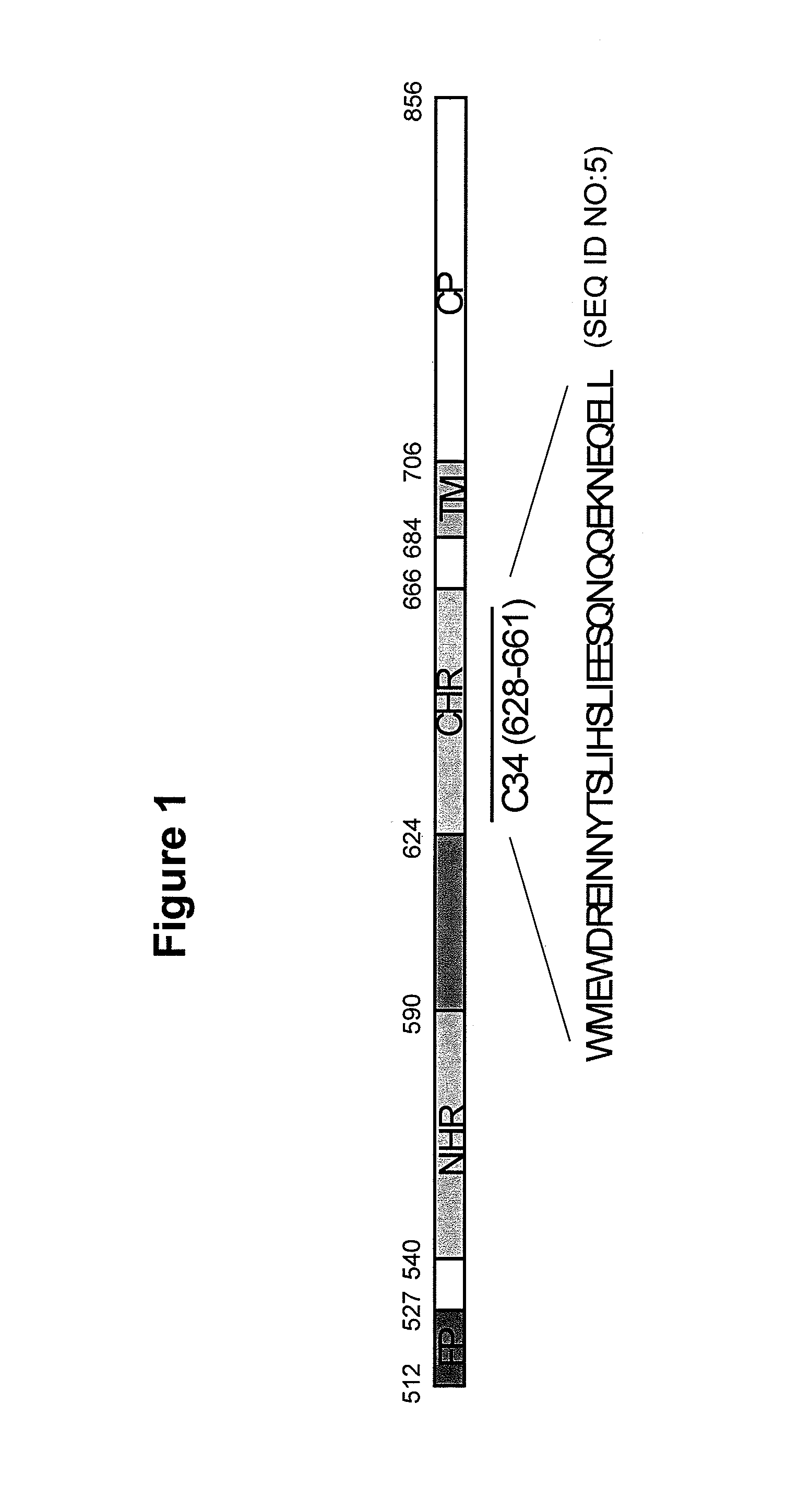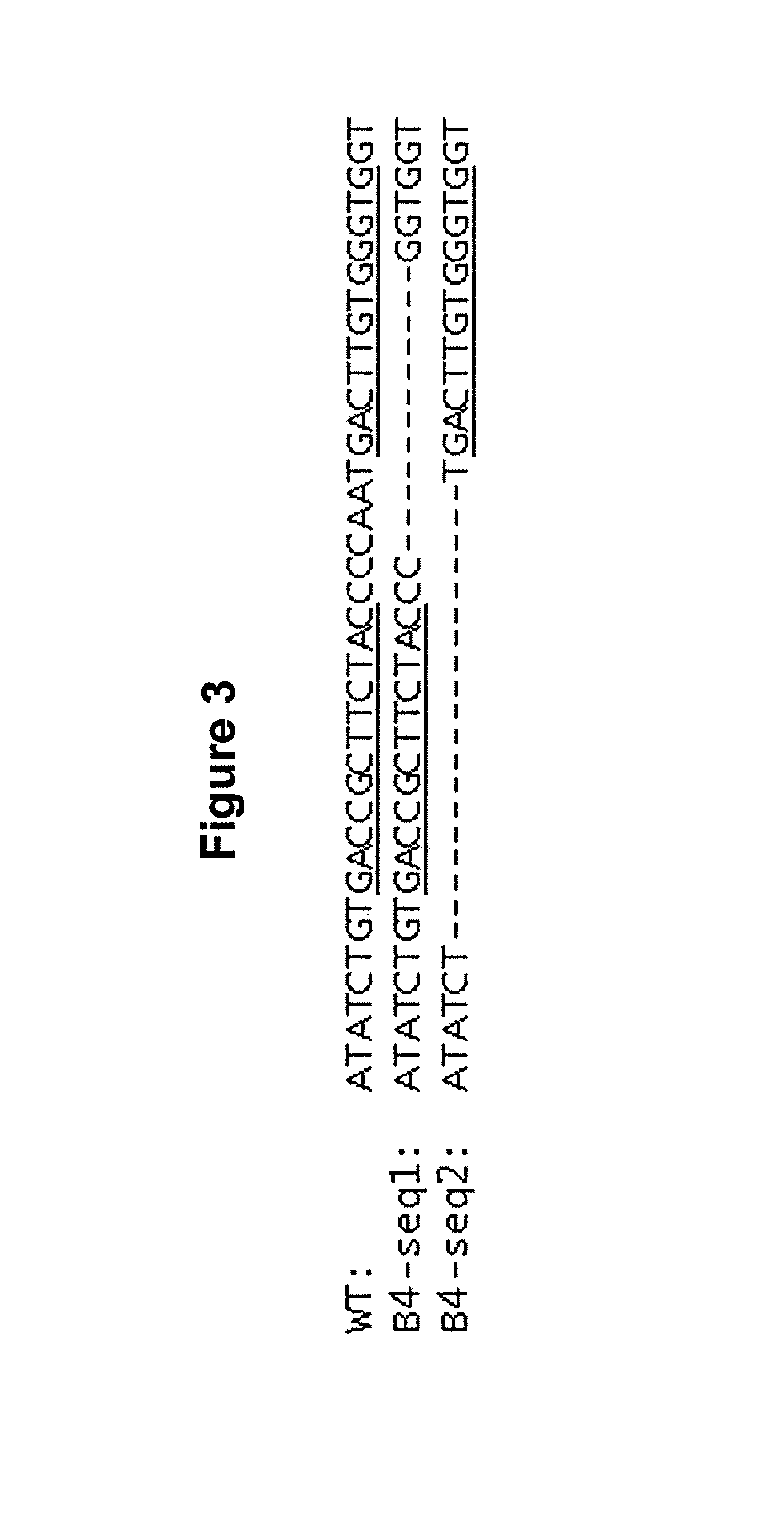Methods and compositions for inhibiting viral entry into cells
a technology of viral receptor and cell, applied in the direction of viruses, peptides, tissue culture, etc., can solve the problems of undesired consequences of knocking out or disrupting viral receptors such as cxcr4
- Summary
- Abstract
- Description
- Claims
- Application Information
AI Technical Summary
Benefits of technology
Problems solved by technology
Method used
Image
Examples
example 1
Disruption of Endogenous CXCR4 Gene and Reconstitution with a Sequence Encoding a Fusion Protein Composed of the Peptide Fusion Inhibitor C34 and CXCR4
[0141]Endogenous CXCR4 gene was disrupted by ZFN-mediated genome editing, followed by re-introduction of a sequence encoding a fusion protein composed of C34 and CXCR4 (C34-CXCR4 or more specifically, C34-X4b as the predominantly transcribed / expressed form, isoform b of CXCR4 was used in these studies) to render the modified cells resistant to HIV infection but responsive to CXCL12 signaling through random integration of the gene encoding the C34-CXCR4 fusion. In particular, the CXCR4− / − SupT1 B4 cell line described in U.S. Patent Publication No. 20100291048 was used as the parental cell line to generate a C34-CXCR4 transfectant. One CXCR4 allele of the parental B4 SupT1 has a 12 bp deletion, the other CXCR4 allele has a 19 bp deletion in exon 2 (FIG. 3A).
[0142]The parental CXCR4− / − B4 SupT1 cells were transduced with lentiviral const...
example 2
Functional Response to CXCR4 Ligand
[0153]Functional responses of cells to the natural CXCR4 ligand CXCL12 (also called stromal-derived factor-1, SDF-1) were also evaluated using a transendothelial migration assay (Wang et al. (1998) Leukoc Biol 64(5):642-649). Briefly, the hybrid endothelial cell line EA.hy926 (ATCC) was cultured in transwell inserts (Corning) with 5 nm pores at 37° C. for 3 days. The indicated SupT1 cell lines were loaded into the washed transwell inserts (upper part of the transwell), whereas SDF-1α was added into lower part of the transwell (outside of the inserts). Cells were allowed to migrate at 37° C. for 4 hours, then centrifuged at 1400 rpm for 5 min, and collect for counting with a Guava flow cytometry. The frequency of migrated cells (% of input) was calculated using the following formula: Frequency of migrated cells (% of input)=(number of migrated cells) / (total number of cells added into the transwell insert)×100%.
[0154]As shown in FIG. 4, the WT SupT1 ...
example 3
Resistance to HIV Infection in C34-CXCR4 Containing Cells
[0156]To evaluate whether fusion of the C34 peptide to the N-terminus of CXCR4 co-receptor protein renders cells resistant to HIV-1, the B4 SupT1 transfectants were infected with an X4-tropic HIV-1 strain HXB or a R5 / X4 dual-tropic HIV-1 strain R3A and monitored for viral replication by a reverse transcriptase assay. Briefly, cells were plated at 1e6 cells / ml and spin-infected with the indicated HIV-1 strains for 1 hour at 1,500 rpm. Cell culture supernatants were collected over the course of 2 weeks to measure HIV-1 reverse transcriptase (RT) activity
[0157]As shown in FIG. 5, regardless of the HIV-1 strains used, significant viral replication in the X4b-WT transfectants was detected 7 days post-infection and continued to be about 3 logs higher than background levels 2 week-post-infection. In contrast, no viral replication was detected in the C34-X4b or GFP transfectants as well as the parental B4 SupT1 cells during the experi...
PUM
| Property | Measurement | Unit |
|---|---|---|
| affinity | aaaaa | aaaaa |
| time | aaaaa | aaaaa |
| compositions | aaaaa | aaaaa |
Abstract
Description
Claims
Application Information
 Login to View More
Login to View More - R&D Engineer
- R&D Manager
- IP Professional
- Industry Leading Data Capabilities
- Powerful AI technology
- Patent DNA Extraction
Browse by: Latest US Patents, China's latest patents, Technical Efficacy Thesaurus, Application Domain, Technology Topic, Popular Technical Reports.
© 2024 PatSnap. All rights reserved.Legal|Privacy policy|Modern Slavery Act Transparency Statement|Sitemap|About US| Contact US: help@patsnap.com










